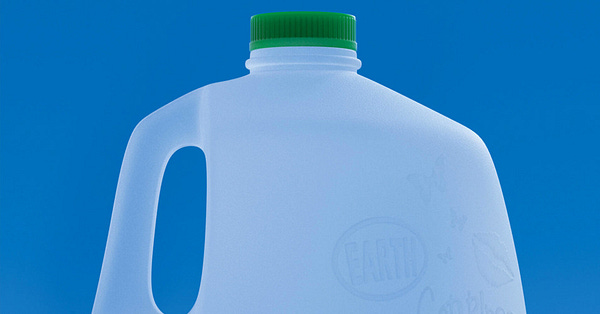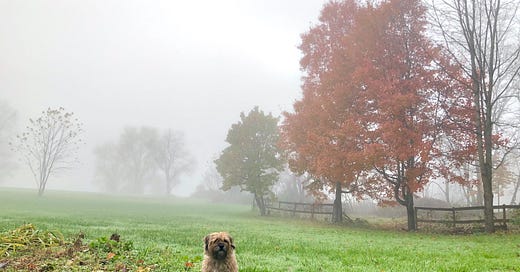Hello Readers,
We’ve been waking up to foggy and frosty mornings here in the Connecticut River Valley. We’ve been doing some of the autumn-in-New-England things—going to an apple orchard, taking pictures of trees, thinking about buying a wood-chipper. . .
My nephew-the-soil-scientist came to visit a while ago. He strongly believes that for me to get a wood-chipper that can really do the job would be way too expensive. Better to just rent a good one a couple of times a year, he says. Yet he knows how important it is, especially if I am going to plant some apple trees. We sat at the dinner table and talked about soil for two-and-a-half hours.
I’d already been pointed in the right direction by a wise book called The Holistic Orchard, by Michael Phillips, who is a farmer, writer, carpenter, and “orchard consultant” who grows apples in northern New Hampshire. He puts this nugget right up front: “Human health is a function of plant health, which is a function of soil health, which in turn is a function of fungal health.” And to support fungal health, we need ramial wood chips. As Phillips explains it, “The tops of deciduous trees and woodsy shrubs . . . pruned and subsequently run through a chipper into coarse pieces are what rock the biological kasbah.”
So the very first stage of planting the small orchard we want is to test the soil, understand the water table, and then make sure we get a good “soil food web” started. “System health springs from the biology of the soil,” Phillips writes, not from the use of toxic fungicides and pesticides. The trees can get everything they need organically.
There’s a great future in plastics
The organic farming way of thinking connects with my earliest ecological awareness, which came from taking a biology course at the University of Wisconsin, in which—to my everlasting gratitude—we were assigned The Closing Circle, by Barry Commoner. I’ve carried this book around with me ever since, and have turned to it several times when writing about our despoiled world. In recent months, I picked it up again. The Baffler was preparing an issue about garbage and waste, which we called “The Squandering Earth,” and I volunteered myself to write about the oversupply of plastics and the underwhelming potential of recycling. (Yes, I quoted that line from The Graduate.)
You can get some understanding of the deceptiveness of those “chasing arrows” in this article; you might be surprised that the current value of plastic milk jugs on the secondary market is currently higher than aluminum; and you might also appreciate the journalistic recycling I did by relaying key stats and insights from a recent issue of Science magazine devoted to “Our Plastics Dilemma.” But the part of the piece that means the most to me comes at the very end. I hope readers make it that far! I turned to Dr. Commoner to put the ecological madness of a petrochemical-fueled plastics industry into perspective. Which he did—even though his book came out in 1971, a few years before the now-ubiquitous PET plastic soda bottle hit the market, due to the efforts of a DuPont scientist named Nathaniel Wyeth, who was, yes, the brother of the painter Andrew Wyeth.
(One of my super-talented young colleagues reacted to this factoid by photoshopping the famous “Christina’s World” so that Christina was prone in a field of plastic soda bottles. That image has not yet been made public, but it enlivened our evening while we were deep into proofreading.)


I must now confess that it felt peculiar to be writing, in the fall of 2021, about plastics, and recycling, and ecology. I spent a lot of time in the 1990s learning about solid waste systems. (I used to edit a local newspaper.) And though some could attest that I quite often, even today, go on kitchen harangues about what plastics go in the bin and how infuriating it is that Americans know so little about our trash problems, I was aware as I was working on this article that . . . how to put this? These problems have not been uppermost in my worried mind lately.
Our freedoms
I’ve been so vexed in the past year about the militant resistance in the middle of a pandemic to what seem to me the tiniest expressions of concern for the public health and safety. You put a piece of material over your face when in public and you take 30 minutes to go get a shot. Half the country says OK, let’s do that. Perhaps another 25 percent can’t be bothered to do anything, and have only vague suspicions because they heard from someone that something happened to someone. And then a vanguard of resisters who are “doing their research” are living in an alternate reality in which their freedoms and bodily integrity are under mortal threat, and they will not have it.
Knowing some resisters, I’ve tried to understand “where they’re coming from.” It’s not been a waste of time. I’ve been willing to admit we all take our leaps of faith. Every time you turn to the medical profession you are ardently hoping there is such a thing as expertise. I can see why there’s doubt. A lot of respected doctors got unsuspecting people hooked on opioid pain-killers; they were doing the bidding of Big Pharma. And these doctors are not referred to as “quacks.” But that doesn’t mean the actual quacks aren’t profit-driven quacks. Get your special magic tanning bed from Dr. Mercola and see if all your ailments go away. I happen to know someone who is getting ivermectin every month: it’s my dog, who enjoys a chewable Heartgard to ward off heartworms, at 68 mcg. I’m willing to trust “establishment medicine” on the suggestion I shouldn’t drop one into my own bowl of cereal to ward off Covid-19. (My sister reports ivermectin is quite effective against head lice, though.)
As the few people who been subjected to dinner conversation with me over the last year and a half could attest, this surprising development of parallel pandemic universes is what I tend to rail about most. Maybe it should not have been a surprising development. In every pandemic in U.S. history there have been people who see vaccination as some evil plot, and have seen organized efforts to promote vaccination as the beginning of dictatorship.
And hasn’t it always been an inescapable fact of political life that nobody can agree on anything? It was true in 1980 that perhaps half the country could not fathom why the other half would vote for a washed-up movie actor for president. By the time a washed-up real estate tycoon/ TV celebrity was elected in 2016, it was painfully obvious that Fox News viewers were in a different America than New York Times readers.
The Baffler published an essay a while ago by Adrian Nathan West that explores our epistemological breakdown better than I can. It’s called “What Does a Fact Look Like?” West reminds us that David Hume observed a long time ago “Nothing is demonstrable.” If you’ve had arguments (or discussions!) with people on the other side of the vaccination question than you’re on, that’s pretty much what you conclude. Nothing is demonstrable.
Not an uplifting thought for someone whose line of work is political argumentation! Nevertheless, we sometimes can’t help ourselves, and so I will also call your attention to my recent attempt to mull over a question that’s been on my mind since this country took that hard right turn in 2016. I’ve thought about it sometimes as “the Kissinger conundrum.” You can have a powerful American official who is, literally, guilty of war crimes, and yet never loses his place of respect in the upper echelons of the American elite. And then Trump comes along, and doesn’t come close to the record of international carnage of Nixon/Kissinger or of Bush/Cheney, and yet . . . He seems to make many of us fear we are on the verge of turning this country into something much, much worse than it already is. Why? The answer, I argue here in “The Good, the Bad, and the GOP,” is because he’s taken control of the Republican Party and demanded the ultimate victory—over the fair and just functioning of democracy itself.
There was long a dream on the American far right that democracy’s expansion could be halted. It began to gather force under Reagan; it soldiered forward under Bush and Cheney. But it became the driving force of the GOP under Trump. The dream is of a permanent majority for white Republicans. It could be called the quest for Final Victory.
Pump up the jam
This is life in the U.S.A., these days, I guess. We might be starting our day with dreams of an organic orchard and then before long we are sullenly contemplating the death cult of Trumpism and the end of democracy. I’d like to think there is some hope for this country—feel free to send me any evidence!—but a lot of things feel fundamentally different than they did in the Reagan years, as bad as they were then.
By the way, my hero Barry Commoner ran for president in 1980 and tried to start up a Citizens Party. He was much better at science and ecology than political party building, though. It’s magical thinking, but I can’t help saying it: What a different country we’d be in if we would have followed his lead instead of Reagan’s!
Let’s turn to a couple of Canadians to lighten the mood. Is this good? I think it’s good. Sound up. Then, sound off in the comments.




